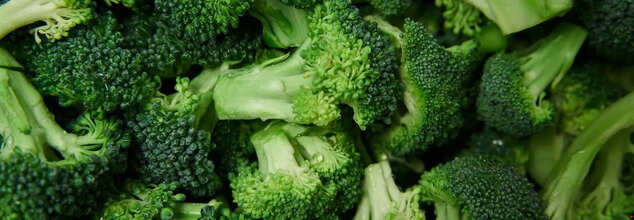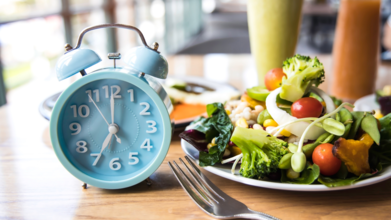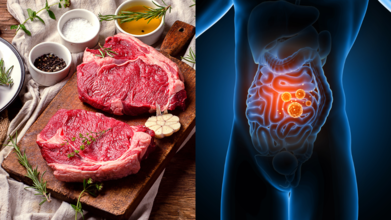- Health Conditions A-Z
- Health & Wellness
- Nutrition
- Fitness
- Health News
- Ayurveda
- Videos
- Medicine A-Z
- Parenting
- Web Stories
Broccoli Has More Vitamin C Than Oranges—Here Are 9 Foods That Pack an Even Bigger Punch

Credit: Canva
When we feel a cold coming on, many of us instinctively reach for vitamin C to boost our immune systems. The same applies to when we have an ongoing flu season or any other outbreak. While supplements are convenient, getting vitamin C directly from food can be just as effective—and sometimes even more so. But did you know that besides the most popular Orange, there are a range of popular fruits that are packed with Vitamin C. While a medium-sized orange contains around 70 mg of vitamin C, several other foods pack an even more powerful punch.
Here Are Fruits That Contain More Vitamin C Than Oranges
1. Strawberries
A cup of fresh strawberries offers 97.6 mg of vitamin C, surpassing the amount found in a single orange. Along with their vitamin C content, strawberries provide magnesium and folate, essential for blood sugar stability and heart health.
2. Broccoli
Raw broccoli contains approximately 81 mg of vitamin C per cup — close to the recommended 90 mg per day. Additionally, this cruciferous vegetable is rich in vitamin K, which supports bone health and blood clotting.
3. Bell Peppers
Bell peppers — particularly the yellow variety — can contain up to 341 mg of vitamin C per large pepper, nearly five times that of an orange. Red and green bell peppers also pack a substantial dose of this immune-boosting nutrient and are a low-calorie, fiber-rich snack.
4. Kiwi
This small but mighty fruit delivers 128 mg of vitamin C per serving (about two kiwis). Kiwi is also loaded with copper, potassium, and serotonin, which may improve sleep quality.
5. Brussels Sprouts
One cup of Brussels sprouts provides 97 mg of vitamin C, along with fibre and cancer-fighting phytonutrients. Roasting them can bring out their natural sweetness and reduce their bitter taste.
6. Kale
A cup of kale offers 91 mg of vitamin C, plus an impressive seven times the daily recommended value of vitamin K. This leafy green is also a good source of minerals and omega-3 fatty acids.
7. Pineapple
Pineapple contains 79 mg of vitamin C per cup and is packed with bromelain, a natural enzyme that aids digestion and reduces inflammation.
8. Papaya
With 88.3 mg of vitamin C per cup, papaya is known for its anti-inflammatory properties and its ability to brighten skin and clear sinuses.
9. Cauliflower
A head of cauliflower can provide a staggering 266.8 mg of vitamin C, along with ample fibre. Steam, mash, or roast it for a nutritious, versatile meal option.
Intermittent Fasting For These Many Hours Could Ruin Your Heart Health

(Credit-Canva)
We know that the kind of food you eat has a big impact on your health, but what about the timing? Scientists are starting to discover that when you eat may be just as important. In the past, people naturally had periods of fasting when food was scarce. Intermittent fasting, or fasting diets, focus on limiting when you eat. While there are potential benefits of it, a new study has revealed it could lead us to have health issues as well.
A new study published in the journal Diabetes and Metabolic Syndrome suggests that following a daily eating window of less than eight hours—a form of intermittent fasting—could double the risk of death from cardiovascular disease. While many people use intermittent fasting for weight loss and other health benefits, this research indicates a potential hidden risk.
How Do Long Fasts Cause Heart Problems?
The study, which analyzed data from over 19,000 U.S. adults, found that those who ate for less than eight hours a day had a 135% higher risk of dying from heart and blood vessel diseases like heart attacks or strokes, compared to people who ate within a 12 to 14-hour window. The researchers, led by senior author Victor Wenze Zhong, found that this link held true across different racial, ethnic, and socioeconomic groups.
The study did not find a link between this eating pattern and a higher risk of death from cancer or other causes. However, Dr. Zhong urged caution, stating that there is currently no long-term evidence from human studies to support using a very short eating window for heart health or longevity.
Can Fasting Harm Our Health?
According to the National Institutes of Health, fasting can potentially harm your health, especially if done for long periods. The article notes that studies have found a higher risk of gallstones in people who fast for more than 16 to 18 hours a day. These individuals are also more likely to need surgery to have their gallbladder removed.
The text also strongly advises that certain people should avoid fasting altogether. This includes individuals with specific health conditions or those taking certain medications. The information emphasizes that more research is needed to fully understand the effects of fasting. It concludes with a warning to talk with a doctor before trying any fasting diet, especially those that are not based on research.
Is Intermittent Fasting Right for You?
While fasting may have health benefits, experts warn that we still have a lot to learn. Some studies have linked fasting for more than 16 hours a day to a higher risk of gallstones. However, many experts agree that a 12-hour eating window followed by a 12-hour fast is likely safe for most people and matches eating patterns seen in people with long lifespans.
If you are considering a fasting diet, it's essential to talk to your doctor first. People with certain health conditions or those on specific medications should not fast. And remember, what you eat still matters—even if you fast, you still need to make healthy food choices.
Not Drinking Enough Water Could Spike Your Stress Hormones, Study Warns

Credits: Canva
When you think of drinking too little water, you can imagine the headaches, drowsiness or the parched mouth signalling dehydration but recent research indicates something much more complicated may be at work in the body, and so to say your mom was right about it- drinking insufficient water could be quietly magnifying stress, paving the way for long-term illnesses.
A research article in the Journal of Applied Physiology found that those consuming less than 1.5 liters of fluid per day had a 50% greater increase in cortisol, the body's main stress hormone, in difficult situations than those who hydrated according to guidelines. The discovery moves the hydration debate away from dehydration exclusively and toward stress resilience—a consideration with far-reaching impacts on cardiovascular, metabolic, and mental well-being.
Cortisol is the stress-fighting hormone that assists the body in responding to stress, but when elevated too long, it creates more problems than it solves. Long-term high cortisol has been linked to heart disease, type 2 diabetes, obesity, depression, anxiety, and compromised immunity.
The researchers at Liverpool John Moores University wanted to know if mild dehydration could affect the way the body responds to pressure. They tested this by grouping healthy young adults into two groups:
Low fluid group: less than 1.5 liters a day
High fluid group: reaching or surpassing recommended standards (2 liters for women, 2.5 liters for men)
Both groups underwent a Trier Social Stress Test that consisted of a simulated job interview followed by quick succession mental math. While both groups were equally anxious and had elevated heart rates, the low-fluid group's cortisol levels jumped astronomically higher, indicating water consumption has a direct impact on stress reactivity.
How Hydration Controls Hormones?
To see why, we have to examine the water-regulation system in the body. When we become dehydrated, the brain causes the release of vasopressin, a hormone that instructs the kidneys to hold on to water. But vasopressin doesn't quit there. It also acts on the hypothalamus, the brain's stress center, triggering further release of cortisol.
This produces a twofold effect: while the body is preserving water to avoid dehydration, it also increases stress responses. For an individual with work deadline pressures, family responsibilities, or money worries, this increased stress reactivity might compound into long-term health issues.
A Real-World Experiment in Stress and Hydration
The trial model replicated daily stressors. Participants received only 10 minutes' preparation time before confronting interviewers in white coats in front of mock cameras, after which they received stern math problems. Saliva samples taken at baseline and after showed sharp contrasts: those who consumed less water on a consistent basis had darker urine, worse markers of hydration, and much stronger cortisol responses.
What is surprising is that the members of the low-fluid group didn't actually perceive themselves as thirstier than others. That means that even if they didn't have apparent dehydration symptoms, their bodies were still being stressed—a hidden vulnerability many of us may be missing.
The health effects reach beyond transient nerves. Chronically elevated cortisol can slowly increase blood pressure, interfere with blood sugar control, and weaken immunity. It might even lead to premature aging and lower stress resistance later on.
Indeed, it was recently reported by the British Heart Foundation that there was a disturbing increase in cardiovascular deaths among UK working-age adults—a trend predicted partly to be caused by stress and lifestyle. If stress hormone regulation is as much affected by hydration as these results indicate, it is possible that something as mundane as water consumption could be a factor in reversing this path.
How Much Water Is Enough?
Varying slightly from country to country, public health advice recommends:
Women: about 2 liters per day
Men: about 2.5 liters per day
This includes all fluids—water, tea, coffee, milk, and water-rich foods. Still, actual needs vary based on climate, physical activity, and health status. Pregnant and breastfeeding women, for example, often require more.
The easiest way to monitor hydration? Check urine color. Pale yellow typically indicates good hydration, while darker shades mean it’s time to drink more.
How To Use Hydration as a Stress-Management Tool?
We already understand that sleep, exercise, and diet define stress resilience. Hydration now has its place on that list. Drinking more water won't eliminate the pressures of life, but it can dull the body's physiological overreaction to them.
As Dr. Daniel Kashi, a study author, put it, "Though the low-fluid group did not say they felt thirstier, low hydration was obviously linked with higher cortisol reactivity. Over time, that hyper-responsiveness could add up to poor health in the long run."
The scientists are now investigating if increased water consumption in under-hydrated persons can decrease daily stress reactions—such as traffic jams, presentations, or impending deadlines.
Chronic stress has been termed a contemporary public health crisis, spurring everything from cardiovascular disease to mental illness. Most strategies for reducing stress such as meditation, therapy, or life redesign—take considerable time, expense, or infrastructure. Hydration, in contrast, is universal and within reach.
That does not translate to water being a panacea. The research was done under laboratory conditions and only with young, healthy adults. There is a need for more research to validate whether sufficient water can help alleviate stress-related medical issues in a wide range of populations and over many decades. Nevertheless, the potential for a low-cost, daily routine to alleviate stress is worthy of consideration.
With stress seeming inevitable in today's world, giving the body every possible advantage matters. Good health is seldom the result of a single sensational intervention but of constant, daily habits. Having a water bottle handy may be one of the smallest, most practical, and most powerful first steps toward resilience.
Beef, Pork, and Lamb Might Do More Than Fill You Up; Study Finds They Could Be Flaring Up Your Gut

Credits: Canva
Gaining weight by eating too many lamb chops or beef burgers is not the only risk. A new study published in Molecular Nutrition & Food Research suggests that red meat might be less of a comforting indulgence and more of a gut irritant. According to researchers at Capital Medical University in China, diets overloaded with pork, beef, or mutton could stoke inflammation inside the digestive system, potentially worsening gut-related disorders.
The Experiment
Scientists turned to an animal model. Mice were fed a diet high in red meat before being given a chemical that induces colitis, a condition that resembles inflammatory bowel disease (IBD) in humans. Results showed that the red-meat-fed mice experienced significant weight loss, shorter colons, and visible tissue damage. Their immune systems also went into overdrive, flooding the gut with inflammatory cells. Essentially, the study found that when the gut is already irritated, red meat makes the fire burn hotter.
All Red Meat Counts
Before you point fingers at beef or lamb individually, the researchers clarify that the issue is not with one specific type of red meat. The effect was observed across the board, whether it was pork, beef, or mutton. The common thread was the way red meat in general seemed to intensify inflammatory signals in the gut.
Gut Bugs in Trouble
One of the most striking findings was how red meat tampered with the gut microbiome—the trillions of tiny organisms that work quietly to regulate digestion and immunity. In the study, mice on red meat lost beneficial bacteria, particularly those that protect the gut lining and keep inflammation low. In their place, harmful microbes took over, making the digestive tract more vulnerable.
Why This Matters for Humans
While the experiment was done in mice, the implications for humans are worth paying attention to. People with conditions like Crohn’s disease or ulcerative colitis often report flare-ups after eating red meat. The study offers a possible explanation for this: the combination of heightened inflammation and a disrupted microbiome makes the gut more sensitive. For those already battling IBD, red meat might be less of a protein-packed friend and more of a troublemaker.
The Moderation Mantra
Does this mean you should swear off meat forever? Not necessarily. The researchers were clear that the study does not prove red meat directly causes IBD or that it should be completely eliminated from your plate. Instead, moderation seems to be the golden rule. If you do enjoy red meat, balance it out with plenty of fibre, fruits, vegetables, and lean proteins such as fish or chicken. A varied diet gives your gut a better chance of staying healthy and less inflamed.
Handle with Care
Red meat has long been under scrutiny for its links to heart disease and cancer risk, and now gut health joins the list of concerns. While more human studies are needed, the findings serve as a gentle nudge to reconsider how often you pile your plate with steak or kebabs. Your gut microbiome is like a delicate ecosystem. Treat it kindly, and it will return the favour.
© 2024 Bennett, Coleman & Company Limited

